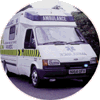NTL considers itself the "complete communications company, a company that can deliver virtually any kind of communication from anywhere to anywhere, by whatever medium is most effective."
The company operates extensive networks across all of the key communication technologies - fibre optic, broadband coax and copper, broadcast, satellite and radio. They are experts in all of the key applications - telecommunications, television, radio, Internet and mobile radio.
Across the UK, NTL works with businesses, education and healthcare organisations and local authorities, providing essential communication solutions.
For more than a million consumers, NTL is the company that supplies telephone, Internet and television services.
For numerous TV companies and radio broadcast stations, news services, mobile phone operators, emergency services and Internet service providers, NTL carries their information to its destination.
(This section was paraphrased from the NTL website)

We were involved with NTL from September 1997 until May 1998, working with the Radio Communications group on the development of a mobile data system for a northern county ambulance trust.
The company wrote the embedded C application for the ambulance data terminal. The mission-critical application ran on an Arcom data terminal running a real-time multi-tasking operating system in an Intel 80C186 processing environment. The program comprised several layers of services:
- An event-driven user interface. The key to the succussful acceptance of the data terminal by the ambulance crew was the clear, unambiguous presentation of information, together with a variety of time-saving measures. The presentation of attendance instructions on a textual display delivered via a fast data link improved the existing system of receiving instructions over a voice radio link and was thought to reduce the time taken to get the ambulance on its way by up to 30 seconds, a crucial time advantage in many emergencies. For each incident, screens of information were presented to the crew, including the attendance address, information about the incident and any medical records available for the patient. The data terminal progressed through a series of states, triggered by the crew responding to the initial paging, reading the attendance instruction, starting to move the ambulance, arriving at the scene of the incident, departing for the hospital (if appropriate) and finally unloading the patient and becoming available once again for further work. The terminal provided a best guess of the probable next state, ensuring that the amount of button pressing required of the crew was kept to a minimum for the majority of cases.
- A high level communications protocol for the radio data link provided guaranteed, authenticated delivery of data messages between the mobile data terminal and the command and control system. The system employed a variety of variable format messages, allowing the full spectrum of ambulance and related functions to be implemented. The protocol provided for long attendance instructions being delivered to the ambulance data terminal, as well as short acknowledgement-type messages. The requirement for the message delivery to be guaranteed arose primarily because of the existence of radio black spots caused by the hilly terrain. The fact that the ambulance could travel through areas where there was no radio reception and no possibility of the command and control system receiving any status updates meant that a store and forward mechanism had to be designed into the messaging system. This ensured that once radio coverage was regained, any pending data messages were transmitted in the correct order, allowing the full history of the incident to be logged by the Command and Control system.
- A low level interrupt-driven communications protocol for the Thorcom data modem. The data terminal communicated with the data radio via a data modem. The protocol operated by the modem provided a robust link between the data terminal and the radio and between the radio and the hill top base station.
- A low level interrupt-driven communications protocol for the VHF/UHF voice repeater, which paged the ambulance crew when they were absent from the vehicle. This allowed the crew to be recalled to read the new attendance instructions on the data terminal if an urgent incident occurred.
- Automatic data messaging processes allowed the Command and Control system to determine exactly when emergency attendance instructions dispalyed on the data terminal were read and when the crew responded to their pagers when they were away from the ambulance. This allowed precise operational statistics to be obtained and ensured that the crews performed to their maximum potential.
- Administrative tools, accessible via password protected screens provided Supervisors with additional functionality, allowing the performance of the equipment and the crew to be monitored.


The new network utilises 12 transmission sites linked to the control centre, 53 ambulances based at 24 ambulance stations and 85 patient transport vehicles, covering an area in excess of 1,150 square miles.
NTL provided a private mobile radio system (PMR) and a fully integrated communications control system (ICCS) to improve their flexibility of operations. Details of incoming emergency 999 calls are entered into a sophisticated Computer Aided Dispatch (CAD) system at the ambulance control centre for immediate dispatch of the vehicle assigned to attend.
The ambulance paramedics are paged via UHF mobile handsets to indicate that a message is waiting on the mobile data terminal even when they are away from the ambulance.
The Mobile Data system uses an advanced, high-speed data transmission system that relays information directly between ambulances and the command and control system. This reduces response times whilst providing resilience against the failure of any part of the radio communication system.
The use of digital data transmission technology reduces the time taken to dispatch details to crews from controllers and improves the accuracy and security of the information communicated.
(This section was paraphrased from the NTL website)